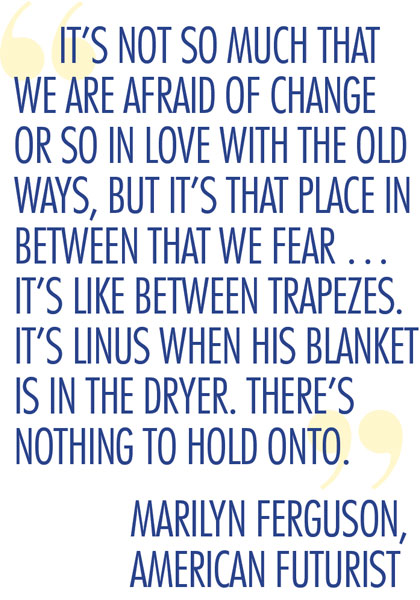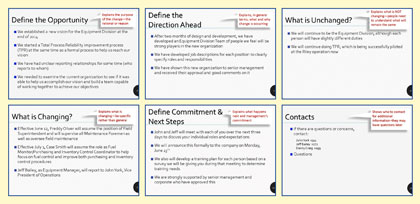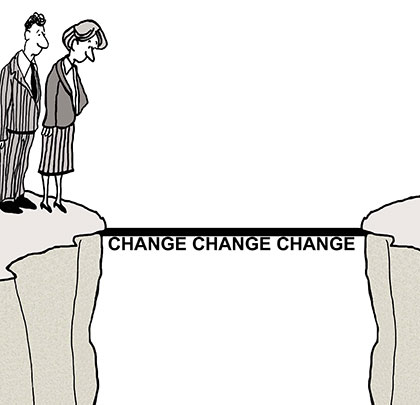Change is defined as a shift from one way of doing things to a different way of doing things. It can be incremental or radical (evolutionary versus revolutionary). Transition is the process people experience when undergoing change. Change Management is the sequence we use to manage the process of transition.
Successful organizations understand that doing things the same way will produce the same result and that changing things for the better is needed to take an organization to the next level.
Without a doubt, change is a word that creates a great deal of nervousness with many folks. All of us certainly can think of numerous positive changes that have occurred in our lives. However, when you hear “we are going to be changing that soon,” most of us get anxious, and the question we all ask is why?

After all, we know that progress comes from change, and that complacency causes stagnation. So, what causes so much apprehension in the change process? To answer that we must first discuss the ways in which people react to change in order to get to a different result. The realities of change are that people:
- Are at different levels of readiness to accept change
- Can handle only so much change at one time and still function
- Feel awkward, ill at ease, and self-conscious about changing
- Generally fear the unknown because it is different, which leads to fright and anxiety
- See change as a threat to their habits and comfortable activities
- Will quickly revert to old behavior without consistent guidance and support
- Are concerned that they don’t have enough resources to handle the change
- Focus on what they have to give up rather than what they will gain
- Often feel alone and isolated even if everyone is going through the same change
- Fear the loss of status or position if they can’t adapt or handle the change
- Are therefore concerned for the loss of power or prestige the change may bring
- Are then concerned about the loss of security and predictability
- Are also apprehensive of extra work that the change may require
- Often see the change as poor timing
An excellent book on change behavior and change management by Dr. Spencer Johnson is Who Moved My Cheese? The book does an excellent job of explaining these and other emotional drivers and reactions that hamper how people react to change. More importantly, it lays out how business leaders must communicate change effectively in order to avoid these challenges.

COMMUNICATING CHANGE
Organizational leaders have the responsibility to manage change efforts to minimize the negative impact on employees. We have often seen or experienced well-meaning change efforts that fail, albeit for a variety of reasons. The repercussions of poorly managed change include:
- Resistance and negativity
- Loss of focus on current work responsibilities
- Employee turnover
- Morale problems (absenteeism, more “not my job” attitude, etc.)
- Obstacles to implementation appear
- Loss of reputation of the change leader
How do we avoid this dilemma? Numerous studies have found that in order to effectively manage change efforts, it is important to help people understand what the change will be and the rationale behind the change. The more detailed the communication about the vision for the change, the better employees understand the need and the less resistant they will be to the change.
This awareness is crucial to flattening out a potential bumpy road toward the change destination. A proven process for facilitating this process for smooth change is known as the Management of Change. ■
Look for part two of this article in the next issue of MCS as the process of managing change is explained in detail.
About the Author: Preston Ingalls is president and CEO of TBR Strategies, LLC, a Raleigh, North Carolina-based maintenance and reliability firm specializing in the construction and oil and gas industries. Preston can be reached at pingalls@tbr-strategies.com, or visit www.tbr-strategies.com.
_________________________________________________________________________
Modern Contractor Solutions – June 2016
Did you enjoy this article?
Subscribe to the FREE Digital Edition of Modern Contractor Solutions magazine.



